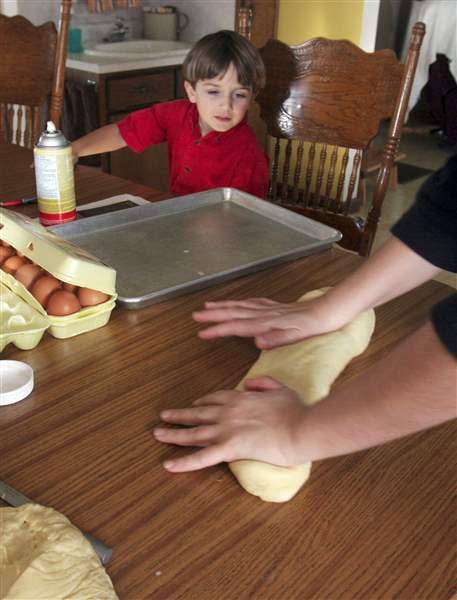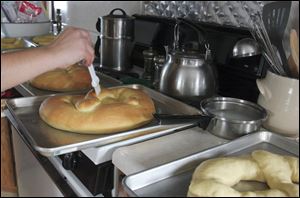
Quest for New Year's Pretzels has many twists
12/21/2010
Kevin Yoder, 4, watches as his mother rolls out Knoerle German bread dough.
The Blade/Lisa Dutton
Buy This Image
Not all quests have such a happy ending.
Like much of her hometown of Sandusky, Terri Dutton Drohan grew up eating New Year's Pretzels. They were in her blood -- her great uncle Charlie Knoerle ran Knoerle's Bakery, one of the town's pre-eminent bakers of the year-end treats. She even lived in the house next door to the bakery for the first five years of her life.
When her Uncle Charlie died, around 1970, the bakery was sold to another family who also lived in Sandusky. And with the bakery went all the recipes.
"It was just amazing, because the bakery patriarch dies and nobody thinks twice about it. We just thought we would always have [the recipes]. To think that he died without giving the recipe to anyone, that he never wrote it down, that was hard," said Ms. Drohan, who now lives in Hudson, Ohio.

Kevin Yoder, 4, watches as his mother rolls out Knoerle German bread dough.
The other family continued to make the pretzels for several years, and so did several other bakeries in town, though Ms. Drohan holds that none of the others was as good as the ones her uncle used to make. But bakeries come and bakeries go, and you don't know what you've got till it's gone. When the other bakery closed, 20 years ago or more, Ms. Drohan and her sister said, "Boy, we'd really like to make those pretzels."
And so a quest was begun, a quest that would span two decades.
New Year's Pretzels are enormous -- at least 15 inches across, and weighing more than 1 1/2 pounds -- and are more like a bread than a pretzel. They are made from a rich, slightly sweet dough. The outside is golden brown and soft, and the inside is a bit yellow from the eggs. Families would eat them by tearing off hunks and spreading them with butter, stuffing them with ham and cheese, or just enjoying them without adornment.
They apparently come from just a small part of Germany, a section of Bavaria and Baden, where they are known as Neujahrspretzel. Residents from that region came to America in the 19th century and brought the tradition to Sandusky, Cincinnati, Pittsburgh, and a few other towns. But just a few.

Marlene Yoder applied the final glaze to a baked pretzel as another one rises on a baking sheet.
"When I went to Kent State and you're sitting around the dorm talking to these kids from all over the place and you start talking about things like New Year's Pretzels, they look at you like, 'What are you talking about?'" Ms. Drohan said.
"I didn't realize it was just a German-Danish tradition. I thought everybody had these."
Her sister, Lisa Dutton, took the search to heart. Ms. Dutton is The Blade's photo assignment editor, and she started inquiring about the recipe in Sandusky and everywhere else she could. Ms. Drohan joined in the search whenever possible -- when visiting Germany several years ago, she even went into bakeries and asked if they knew anything about New Year's Pretzels, but "I came home knowing the same as when I left."
The advent of the Internet made searching easier, but no more successful. The sisters found many recipes, but none came close to the pretzels they remembered. They were all missing something, a special ingredient, but they couldn't discern what it was.
And then Ms. Dutton came across a blog about Sandusky history that mentioned New Year's Pretzels. The first comment on the blog was from a man named Doug Crawford, who began, "I have the original Fuhr family recipe. My grandma Crawford was Ida von Fuhr and her parents had an interest in a bakery in Sandusky."
An e-mail was sent immediately, with Ms. Dutton hoping it wasn't yet another false lead. When the recipe came back, she knew it was the genuine article. Not only were the ingredients right, but Mr. Crawford had also scanned into the computer the sheet of loose-leaf paper that it had been typed on. On the bottom, in pencil, was written, "Knoerle's Bakery. Sandusky, Ohio."
The handwriting was unmistakable. It was that of the sisters' grandmother.
There was still one problem with the recipe: It was written for a bakery. That means it begins with 215 pounds of spring flour, 112 pounds of water, and nine pounds of yeast, and goes all the way down to 30 pounds of lard and eight pounds of whole eggs.
For help turning those proportions into something usable by an ordinary person, Ms. Dutton turned to a friend in Indiana, Marlene Yoder, who is an Amish baker. Together they worked on the recipe until they finally came up with four versions they thought might be right. Ms. Dutton took them to her aunt for validation.
The first one was the wrong color, the second hadn't risen enough. The third one was very close, the aunt said, but it had a little too much mace -- a spice made from the covering of the nutmeg seed -- which turns out to be the special ingredient they had sought for so long.
The aunt didn't even try the fourth sample. She took one look at it and said, "That one looks terrible. Feed it to the birds."
Ms. Dutton and Mrs. Yoder settled on the third recipe, only with less mace. Last week, they baked up a storm, making more than 40 of the treats to bring to pretzel-starved family and friends.
It has been 20 years, but the tradition continues.
Contact Daniel Neman at dneman@theblade.com |or 419-724-6155.